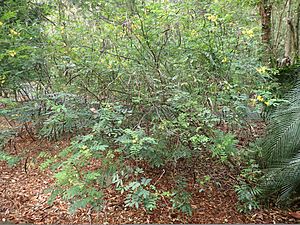Rainforest cassia facts for kids
Quick facts for kids Rainforest senna |
|
|---|---|
 |
|
| In the North Coast Regional Botanic Garden | |
| Scientific classification | |
| Synonyms | |
|
Cassia acclinis F.Muell. |
The Senna acclinis, also known as rainforest cassia or brush senna, is a beautiful flowering plant. It belongs to the pea family, called Fabaceae. You can only find this plant growing naturally in areas close to the coast in eastern Australia. It's a type of shrub that has leaves shaped like feathers and bright golden yellow flowers. These flowers usually grow in small groups of two to five. After flowering, it produces long, thin seed pods. Be careful, though, because it looks a lot like some other Senna plants that are considered harmful weeds in the environment.
Contents
What is Rainforest Senna?
Rainforest Senna is a shrub that can grow up to 3 meters (about 10 feet) tall. Its leaves are special because they are pinnate. This means they have many smaller leaflets arranged along a central stem, like a feather. Each leaf can be up to 150 mm (about 6 inches) long, with a stem part called a petiole that is 20–40 mm long. On each leaf, you'll find five to seven pairs of oval-shaped leaflets, each up to 50 mm long and 15 mm wide. There's also a tiny gland (a special bump) found between the first few pairs of leaflets.
Rainforest Senna's Flowers and Fruits
The bright golden yellow flowers grow in groups of two to five on a stalk called a peduncle, which is 20–40 mm long. Each flower has ten fertile stamens, which are the parts that produce pollen. The tips of these stamens, called anthers, are usually different lengths and are 5–6 mm long. You'll see these lovely flowers bloom in spring and summer. After the flowers, the plant grows flat, long seed pods. These pods are about 120–150 mm long and 6–8 mm wide. They become ripe in summer and autumn. It's important to know that this plant can look very similar to other Senna species that are not native and can cause problems for the environment.
How Rainforest Senna Got Its Name
The Rainforest Senna was first officially described in 1863 by a scientist named Ferdinand von Mueller. He first gave it the name Cassia acclinis. Later, in 1998, two other scientists, Barbara Rae Randell and Bryan Alwyn Barlow, changed its name to Senna acclinis. This new name was published in a scientific journal called Journal of the Adelaide Botanic Garden.
Where Does Rainforest Senna Live?
You can find Senna acclinis in areas close to the coast in New South Wales and Queensland, which are states in eastern Australia. It likes to grow in or around the edges of special forests called subtropical and dry rainforests. This plant is found in several specific areas, including Barrington, Karuah Manning, Mummel Escarpment, Wyong, and Yengro.
Rainforest Senna and Its Friends
Senna acclinis is very important for many insects because its flowers provide food. It's known to be a great plant for pollination, which is how plants make seeds. Many native bees visit its flowers. Even a type of ant called the jack-jumper ant (Myrmecia nigrocincta) has been seen visiting the flowers of S. acclinis many times. The flowers usually appear during the spring and summer months.
Protecting Rainforest Senna
Sadly, Senna acclinis is considered an "endangered" species. This means it's at a high risk of disappearing forever. The government of New South Wales has listed it as endangered under their Biodiversity Conservation Act 2016.
Why Rainforest Senna Needs Our Help
There are several main reasons why this plant is in danger:
- Habitat Loss: Its natural home is being cleared away for new buildings and other developments.
- Invasive Weeds: Other plants that are not native to Australia are spreading and taking over the areas where Rainforest Senna grows.
- Logging: Trees are being cut down in its habitat.
- Accidental Removal: Sometimes, people trying to remove harmful weeds might accidentally pull out Rainforest Senna plants because they look similar.


